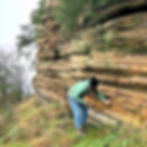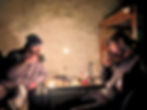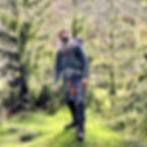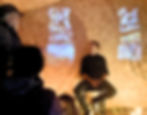HALTBURN: A STORYTELLING RESIDENCY AT THE FIELD SHELTER
- James Lawrence
- Mar 6
- 13 min read
Updated: Mar 13

Link here for video highlights of my week with Field Shelter on Instagram.
WHERE DO STORIES COME FROM?
Back when we lived more closely with our environment, we told stories. Of witches, wolves and woodcutters; of mermaids and Moby Dicks; of gods and the great forces of nature. These stories were entertainment as well as education in how to survive a beautiful yet brutal world. These nuggets of wisdom were passed down through countless generations, always changing to suit the time and place but with roots stretching into prehistory. This was not the history of kings or generals. This was the ‘law of the folk’ - AKA folklore.
Many of these stories contained fantastical beings, which still survive in our imaginations today. Just look at Harry Potter, Lord of the Rings or any other example of the thriving fantasy genre. I believe that these mythical beings ultimately come from our natural environment, and their role in our stories is to explain the unexplainable: the forces that govern our lives, but are beyond our understanding. But over the last few centuries, we in England have become disconnected from our storytelling tradition, as well as our natural environment. Our landscapes are ravaged, our biodiversity is slowly collapsing, and our key national stories are those glamorising ‘the good old days’ of empire and colonialism. Something has to change.
If we can get closer to the source of the fairy tales, maybe we can find a way to re-establish our relationship with nature, and breathe some of that magic back into the world, just when we need it the most. I’ve been interested in this for some time, and in December 2024 I finally got the chance to investigate it once and for all, with a week in Northumberland, at the Field Shelter.

ABOUT FIELD SHELTER
Field Shelter is a creative studio and project space next to Hadrian’s Wall, in those tempestuous lands at the northern edge of England but not quite in Scotland. It’s run by my good friends Lydia Brockless and Ed Corble, who converted an old stable into a place where the art-making process meets the wild, natural landscape. What better place to unplug from modern distraction and embrace a different way of thinking?

Lydia is Field Shelter’s founder, director and resident Artist. I give that word a capital A because she studied sculpture at art school, and has been exhibiting works in prestigious spaces for over 10 years. As opposed to me, who never thought of myself as an artist. I’d recently become interested in storytelling, but I’ve never been to arts school or anything like that. But Lydia is interested in people like me: budding creatives, who don’t traditionally see themselves as artists. This led to her kindly inviting me up to the Field Shelter for a week-long storytelling residency, to develop my artistic practice. I’d never come close to spending a whole week on a creative endeavour before. It was exciting and daunting in equal measure.
One of Field Shelter’s driving principles is ‘landscape-as-studio’: the idea that local natural features can influence art and the process of making it. And what a place to prove it. Northumberland is not only beautiful, but remote; with some of the last true wilderness anywhere in England. The nearby town of Haltwhistle marks itself as the Centre of Britain, which is ironic because this wild region seems to be recorded in maps and books as a borderland, on the edge of everywhere and nowhere. Today it is where the county of Northumberland meets Cumbria and Durham, but 2,000 years ago it was the boundary between Roman and Celt; then Saxon and Viking; then England and Scotland. History records this land as lawless, desolate and dangerous. And then there are the borders not found in books; borders between worlds. These wild and unknowable places are like cracks in reality; spilling forth the stuff of fairy tales and terrible monsters. And unlike the rest of England, Northumberland has held onto lots of those tales, through a strong surviving folklore tradition. It was therefore the perfect place to prove my theory.

THE IDEA
What role does the landscape play in shaping local stories, traditions and legends? And how can we tap into that source to bring back the magic of those stories once again?
To find out, I had a two-pronged plan. I would research local history and folklore, as well as spend time in the landscape and hopefully receive inspiration straight from the source. Then I would share my findings by giving an outdoor story walk performance to the local community.
Sounds great! Except it was in December, meaning that it was cold, wet and dark. But I didn’t really mind: after all, the dark is where the mystery is. So I packed my rucksack and undertook a day’s journey of coach and train up to Haltwhistle to begin my residency and adventure.
THE PROCESS
My base for the week was at the Field Shelter, and the adjoining Bridge House B&B, also run by Lydia and Ed. In the summer the house throngs with tourists and walkers, many of whom are walking the 84 mile Hadrian’s Wall path from coast to coast. The B&B is closed to tourists in December, meaning I received all of the warm hospitality without any of the crowds.
It was a great environment to work from. A minimal, rustic space, immersed in multitudes of previous creations, with views over Hadrian’s Wall and the rolling Northumberland hills. And you could pin stuff right on the wall, which we really don’t get to do enough of these days. The Field Shelter is powered by 100% renewable energy, while the House is powered by an impressive variety of foods produced on site, including eggs from seven bubbly ducks, and vegetables from the allotment. Once you start eating home-pickled veg on a daily basis, it’s hard to go back. It was a great foundational vibe from which I could carry out my work.

Every morning Lydia and I would have a coffee (and the occasional duck egg on toast) to discuss my plans for the day, and anything that needed support. Lydia shared her experience and education as sage guidance on how to bring structure to the creative process - invaluable to a novice like me.
My time outdoors was spent visiting local places and making notes. My indoor time was spent researching (including an afternoon in Haltwhistle library) local history and stories, both ancient and recent. I’d then take my notes back outside to make connections between the stories and the landscape, which in many instances had changed very little over thousands of years.

HALTWHISTLE BURN
For the location of my story walk, I chose Haltwhistle Burn. This burn (a northern term for river) flows off the wild moorland beyond Hadrian’s Wall, through a winding rocky gorge lined with trees and ferns, eventually joining the South Tyne near Haltwhistle. A footpath along the Burn connected Field Shelter to the town. It was an ideal spot to share my findings with the community, and hopefully re-enchant both people and place.
Haltwhistle Burn is one of those places that many locals would think of as as a pretty standard walk We all have them: ordinary places to walk your dog and stretch your legs on the fringes of town, but that’s about it. But like so many of these places, there’s more here than meets the eye. Each time I explored the burn, more and more began to pop out at me:
THE GEOLOGY - talk about rock art. Layers of sandstone in waving lines, nodding to a time when this area was under a shallow sea. Seams of coal, which I had not actually seen up close before; black gold, made from plants, that powered the Industrial Revolution. Limestone made up of old sea creatures, and old leaking alum deposits which looks like liquid moonlight streaking across the floor
THE HISTORY - from the Roman quarry at the top of the path, to the remains of enormous factories, mines and chimneys. The gorge was massively enlarged to make way for massive buildings for works on an industrial scale: mining, brickmaking, wool weaving, gas production and more. Today, nature has reclaimed these works - giving the entire place a very interesting feel
THE FLORA - there were trees, plants and ferns everywhere; at times it felt quite rainforesty. Some of the trees were growing straight out of old slag heaps (how?!) while others had survived the intense industrialisation all around them. Judging by their huge but grizzled demeanour, clearly had some stories to tell
THE MAGIC - speaking of which, lots of the trees had faces. And the rocks had LOADS of faces - in some places, enough to take your breath away. And then there were all the holes in tree roots and rock faces that looked like perfect hiding places for fairy folk. It all lent to the feeling that we were being watched as we walked. Spooky!
The more I began to understand the stories of what had happened here, the more the environment seemed to come alive. They say that the bards, the great storytellers of old, could ‘remember’ the lost stories of a place, simply by walking and spending time there. I started to see why. Ideas for stories beyond the pages of local research started to bubble up inside me. It felt like I was on the right track.

BEYOND THE WALL: AN OVERNIGHT ADVENTURE
To experience the local wilderness in its fullness, I went on an overnight hike. Yes it was winter, dark and cold, but embracing the darkness seemed important to my method of finding lost stories. And boy did I find some.
On a grey Wednesday afternoon I hopped over Hadrian’s Wall, from the civilisation of the south to the wild lands of the north: barely named and barely tamed, feared even by the mighty Romans. As threshold crossings go, this was pretty cool. For 24 hours, I would be alone in the realm of imagination: that fabulous and dangerous place that has given rise to myths and legends for thousands of years.
As I left behind the ridge of Hadrian’s Wall and headed deeper into the bleak expanse before me, I was surrounded by speckling rain and muted hills of waving grass. The track occasionally became a bog, which required ever-more attention to navigate as twilight gave way to darkness. They definitely told stories about people who got caught out in places like this; that’s not how I wanted my story to go.

Just as the last light finally vanished from the sky, I entered a forest of tall conifers. Pitch black and sinister, with creaks and moans all around as the wind whipped through the upper branches. It was unnerving to consider what could be watching you from that darkness.
Eventually I reached the bothy at Haughtongreen. What’s a bothy? They are small buildings found in remote places that anyone is welcome to shelter in - mostly found in Scotland but a few in England and Wales too. Often rustic stone cottages, they’re usually equipped with basic facilities like camp beds and a fireplace. They’re entirely devoid of comfort, which gives them a certain sense of romance.
I’d fancied having the whole place to myself to ponder my imagination and do some writing for my story walk. Imagine my surprise when I arrived to find the fire was already lit, with a cast iron pot bubbling on the stove…

It turned out there were two other lads staying there - quite a surprise for a grey Tuesday in December. I settled in while they played chess by candlelight. One of them mentioned he was going to fill up their bottles with limestone filtered water from a nearby spring. I offered to join: it sounded better than the rain butt. But as we walked to the spring, through open moorland and the inky black of night, past torchlit solitary hawthorn trees, I began to question my decision. The spring turned out to be a single pipe in the middle of nowhere, surrounded by deep sucking mud - one false step could see your leg (and the rest of you) stuck for good. I shivered. This was the signature move of the Duergar: malicious night dwarves who lived in these hills, in houses that disappeared with the dawn, who liked nothing more than luring human travellers to their doom in bogs. Shit! All I could do was keep my balance and my cool while we filled our bottles one by one. Eventually, the job was done and we returned to the bothy unscathed.

It got weirder. The lads kindly offered me some of their dinner: beef hotpot stew, with a HUGE bit of beef, boiled for 6 hours in stock made from beef bones and 3 cans of porter, along with potatoes and veg, in a massive Le Creuset pot, dragged all the way from Chesterfield by train, bus and foot. Well it was goddamn delicious. Maybe the best thing I’d ever eaten. In a bothy? In the middle of nowhere? What was going on?!
We finished our dinner, washed down with the Newcastle Brown Ale I’d brought for poetic inspiration. We then built up the crackling fire, and to thank them for the meal, I told them a tale about the Duergar. They didn’t flinch.

We then got ready for bed. As I hunkered down in my sleeping bag, I realised I’d broken a golden rule of fairytales - DON’T EAT THE FOOD IN THE FAIRY REALM - or you’ll be trapped there forever.
Well enough weird stuff had happened in my day, including a strangely delicious meal, that I genuinely wondered if I would be returning to the mortal realm after all. But in the morning I woke up and everything seemed to be fine. The bothy was still there; so were the lads; so was I.
I went on my merry way and soon found myself wandering off the path and into another conifer forest. This one was ancient; the trees had long beards of lichen festooned from every branch, and thick spongy carpets of moss covered the floor. After some aimless wandering, I stopped and sunk into a giant moss cushion for some breakfast and journaling.

I wondered at the strange, symbolic nature of my journey - this was truly the stuff of fairy tales. I certainly felt the urge to never leave this mossy forest, and live out the rest of my days as a forest goblin. But I tore myself away from the rich silence of that magical place, and eventually found my way back to the path (GPS still works in the fairy realm apparently) and eventually to Hadrian’s Wall, greeted by the cold winter sun beyond.
THE STORM HAG AND THE SHOW
I had returned from my journey in one piece and brimming with inspiration. But other mythical forces were already conspiring against me. Less than 24 hours before the performance, it became clear that Storm Darragh, along with amber weather warnings, would make Haltwhistle Burn unsafe for a story walk. Rather than cancel the event entirely, Lydia and I agreed that we would hold a storytelling performance in the Field Shelter. Remix!
While Lydia and Ed worked tirelessly to contact ticket holders while transforming the Field Shelter from a studio workshop into a performance space, I made some coffee and considered the task before me. I had been working on a dynamic event based on walking, landmarks and stuff to look at. But that had changed to an indoor, intimate space. I would have to try much harder to send my audience’s imagination into overdrive.

After much rewriting but little rehearsal, the time was upon us. Out of the storm, there came an audience: battling their way through wind and rain to the Field Shelter. Hatches were battened down, candles were lit, and homemade carrot cake was served. And as the Cailleach howled and raged beyond the timber frame, we embarked together on a journey of the imagination. A mythical history of Haltwhistle Burn, featuring the following characters:
The Cailleach - storm hag, winter queen, creator, tormentor. She created the land, sea, and Haltwhistle Burn
The Worm - (dragon to me and you) an ancient resident of the Burn, terrorising local villagers but eventually defeated by man’s metal, courage, and the march of progress
The Duergar - the dark dwarves, and their rumoured involvement with the lost 9th legion; an entire army unit of Roman soldiers that appeared to vanish overnight
Queen Mab - a local miller’s dealings with the queen of the fairies, which eventually led to him being cursed as a Kilmoulis…who has no mouth and has to shove food up his nose! Gnarly stuff
Nelly the Knocker\Bluecaps - spirits that ultimately led to the discovery of mineral wealth in the Burn, and great industrial fortune to the area

THE OUTCOMES
I believe that the darkness holds just as many gifts as the light. Yes, the storm threw all my well-laid plans to shit. But the hastily-arranged alternative turned out to be a truly magical experience of its own. I got to sit inside a small converted stable, during a massive storm, and tell stories by candlelight. It felt like a mythic portal to the olden days: it was extremely cool. And the audience seemed to think so too! The performance got good feedback, and some even offered their own stories during the interval and after the show.
They left with a greater connection to their local landscape, local stories, and the power of story in general - a raging storm is good for that. We also raised awareness of the Field Shelter as a great asset in the local community, where art in all its diversity can be found. And now Lydia and Ed know how to flip a studio into a multimedia performance space!
I can also thank the storm for helping to push my creative limits. I was comfortable with leading story walks, but never before had I sat in a small intimate space and told 2 hours of stories to a paying audience. With less than 24 hours to prepare, there was no time for my usual perfectionist instincts - I had to trust that whatever came out of my mouth would do the stories justice. That’s the magic of storytelling; there’s no script; the story is different every time. How differently would my wing-and-prayer performance have come out if there hadn’t been an enormous storm outside to call on?

CONCLUSION
I feel that I’d gotten what I came for: a greater understanding of the link between story and nature.
In our nature-disconnected culture, we urgently need to find ways to embrace our environment once more. Stories are one way to do that. When you engage with the story of a place, you transport yourself to a different world, which ironically helps to embed you in the natural world all around you. When I found the eerie moss-cloaked forest, or the stone cottage with a bubbling pot, my brain was shifted into a different state of being where I could appreciate the majesty (and perils) of wild places.
Stories explain both the benevolent and terrible power of nature, which give or take away life a heartbeat. Even if we think we rely on science more than stories for this advice today, it’s the storytelling in science that puts things in context and ultimately sinks in the knowledge. Just look at the climate crisis threatening civilisation as we know it. As David Attenborough said “Saving our planet is now a communications challenge.”
In this country, despite the enclosures, concrete and carnage of industry, there are still countless stories all around us. The more we connect with our local places, the more we discover these stories. These stories return power to ourselves and our communities; the power in knowing who you are; and makes it less likely that someone else will write you into their story for their own ends.
Above all, this week proved that the stories are out there, waiting to be found. Anyone can find them, whether in the wild Northumberland hills, or the river walk near your house. There are places near you that you think are ordinary, boring and barely worth a second thought. But take time to look up some of the stories that have happened there; just a quick Google search away; and you have the potential to totally transform any space. Take the leap of faith, and you’ll be richly rewarded. That’s magic; and we could all use some more of it.
